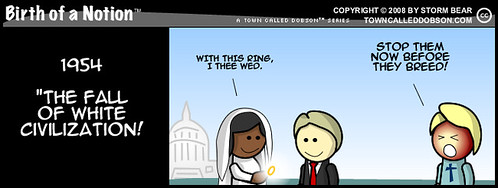 click to enlarge Loving v. Virginia, 388 U.S. 1 (1967), was a landmark civil rights case in which the United States Supreme Court declared Virginia's anti-miscegenation statute, the "Racial Integrity Act of 1924", unconstitutional, thereby overturning Pace v. Alabama (1883) and ending all race-based legal restrictions on marriage in the United States. The plaintiffs, Mildred Loving (nee Mildred Delores Jeter, a woman of African and Rappahannock Native American descent, 1939 – May 2, 2008) and Richard Perry Loving (a white man, October 29, 1933 – June 1975), were residents of the Commonwealth of Virginia who had been married in June 1958 in the District of Columbia, having left Virginia to evade the Racial Integrity Act, a state law banning marriages between any white person and any non-white person. Upon their return to Caroline County, Virginia, they were charged with violation of the ban. Specifically, they were charged under Section 20-58 of the Virginia Code, which prohibited interracial couples from being married out of state and then returning to Virginia, and Section 20-59, which classified "miscegenation" as a felony punishable by a prison sentence of between one and five years. On January 6, 1959, the Lovings pleaded guilty and were sentenced to one year in prison, with the sentence suspended for 25 years on condition that the couple leave the state of Virginia. The trial judge in the case, Leon Bazile, echoing Johann Friedrich Blumenbach's 18th-century interpretation of race, proclaimed that
The Lovings moved to the District of Columbia, and on November 6, 1963 the American Civil Liberties Union filed a motion on their behalf in the state trial court to vacate the judgment and set aside the sentence on the grounds that the violated statutes ran counter to the Fourteenth Amendment. This set in motion a series of lawsuits which ultimately reached the Supreme Court. On October 28, 1964, after their motion still had not been decided, the Lovings began a class action suit in the U.S District Court for the Eastern District of Virginia. On January 22, 1965, the three-judge district court decided to allow the Lovings to present their constitutional claims to the Virginia Supreme Court of Appeals. Virginia Supreme Court Justice Harry L. Carrico (later Chief Justice of the Court) wrote an opinion for the court upholding the constitutionality of the anti-miscegenation statutes and, after modifying the sentence, affirmed the criminal convictions. Ignoring United States Supreme Court precedent, Carrico cited as authority the Virginia Supreme Court's own decision in Naim v. Naim (1955), and also argued that the case at hand was not a violation of the Fourteenth Amendment Equal Protection Clause because both the white and the non-white spouse were punished equally for the "crime" of "miscegenation", an argument similar to that made by the United States Supreme Court in 1883 in Pace v. Alabama. In 1966, the Presbyterian Church took a strong stand stating that they do not condemn or prohibit interracial marriages. The church found "no theological grounds for condemning or prohibiting marriage between consenting adults merely because of racial origin". In that same year, the Unitarian Universalist Association declared that "laws which prohibit, inhibit or hamper marriage or cohabitation between persons because of different races, religions, or national origins should be nullified or repealed." Months before the Supreme Court ruling on Loving v. Virginia the Roman Catholic Church joined the movement, supporting interracial couples in their struggle for recognition of their right to marriage. Prior to Loving v. Virginia there were several cases on the subject of race mixing cases. In Pace v. Alabama (1883) the Supreme Court ruled that the conviction of an Alabama couple for interracial sex, affirmed on appeal by the Alabama Supreme Court, did not violate the Fourteenth Amendment. Interracial extramarital sex was deemed a felony, whereas extramarital sex ("adultery or fornication") was only a misdemeanor. On appeal, the United States Supreme Court ruled that the criminalization of interracial sex was not a violation of the equal protection clause because whites and non-whites were punished in equal measure for the offense of engaging in interracial sex. The court did not need to affirm the constitutionality of the ban on interracial marriage that was also part of Alabama's anti-miscegenation law, since the plaintiff, Mr. Pace, had chosen not to appeal that section of the law. After Pace v. Alabama, the constitutionality of anti-miscegenation laws banning marriage and sex between whites and non-whites remained unchallenged until the 1920s. In Kirby v. Kirby (1921), Mr. Kirby asked the state of Arizona for an annulment of his marriage. He charged that his marriage was invalid because his wife was of ‘negro’ descent, thus violating the state's anti-miscegenation law. The Arizona Supreme Court judged Mrs. Kirby’s race by observing her physical characteristics and determined that she was of mixed race, thereby granting Mr. Kirby’s annulment. In the Monks case (Estate of Monks, 4. Civ. 2835, Records of California Court of Appeals, Fourth district), the Superior Court of San Diego County in 1939 decided to invalidate the marriage of Marie Antoinette and Allan Monks because she was deemed to have "one eight negro blood". The court case involved a legal challenge over the conflicting wills that had been left by the late Allan Monks, an old one in favor of a friend named Ida Lee and a newer one in favor of his wife. Lee's lawyers charged that the marriage of the Monkses, which had taken place in Arizona, was invalid under Arizona state law because Marie Antoinette was "a Negro" and Alan had been white. Despite conflicting testimony by various expert witnesses, the judge defined Mrs. Monks' race by relying on the anatomical "expertise" of a surgeon. The judge ignored the arguments of an anthropologist and a biologist that it was impossible to tell a person's race from physical characteristics. Monks then challenged the Arizona anti-miscegenation law itself, taking her case to the California Court of Appeals, Fourth District. Monks's lawyers pointed out that the anti-miscegenation law effectively prohibited Monks as a mixed-race person from marrying anyone: "As such, she is prohibited from marrying a negro or any descendant of a negro, a Mongolian or an Indian, a Malay or a Hindu, or any descendants of any of them. Likewise ... as a descendant of a negro she is prohibited from marrying a Caucasian or a descendant of a Caucasian...." The Arizona anti-miscegenation statute thus prohibited Monks from contracting a valid marriage in Arizona, and was therefore an unconstitutional constraint on her liberty. The court, however, dismissed this argument as inapplicable, since the case presented involved not two mixed-race spouses but a mixed-race and a white spouse: "Under the facts presented the appellant does not have the benefit of assailing the validity of the statute." Dismissing Monks's appeal in 1942, the United States Supreme Court refused to reopen the issue. The turning point came with Perez v. Sharp (1948), also known as Perez v. Lippold. In Perez, the Supreme Court of California recognized that interracial bans on marriage violated the Fourteenth Amendment of the Federal Constitution. The U.S. Supreme Court overturned the convictions in a unanimous decision, dismissing the Commonwealth of Virginia's argument that a law forbidding both white and black persons from marrying persons of another race, and providing identical penalties to white and black violators, could not be construed as racially discriminatory. The court ruled that Virginia's anti-miscegenation statute violated both the Due Process Clause and the Equal Protection Clause of the Fourteenth Amendment. In its decision, the court wrote:
The Supreme Court concluded that anti-miscegenation laws were racist and had been enacted to perpetuate white supremacy:
Despite this Supreme Court ruling, such laws remained on the books, although unenforced, in several states until 2000, when Alabama became the last state to repeal its law against mixed-race marriage. The definition of a marriage and what constitutes a family was reconsidered by society after the decision of Loving v. Virginia. Following Loving v. Virginia, The Changing Nature of Interracial Marriage in Georgia: A Research Note states "there was a 448 per cent increase in the number of interracial marriages. These numbers are only from the state of Georgia after the Supreme Court ruling, but the numbers and percentages only continued to increase across the United States. However, interracial couples still had to overcome many fears of possibly losing respect from friends, family, and the community. Some activists believe that the Loving ruling will eventually aid the marriage equality movement for same-sex partnerships, if courts allow the Equal Protection Clause to be used. F.C. Decoste states, "If the only arguments against same sex marriage are sectarian, then opposing the legalization of same sex marriage is invidious in a fashion no different from supporting anti miscegenation laws". These activists maintain that miscegenation laws are to interracial marriage, as sodomy laws are to homosexual rights and that sodomy laws were enacted in order to maintain traditional sex roles that have become part of American society. Opponents point out that the United States Supreme Court in the case of Baker v. Nelson, decided just a few years after the Loving decision, summarily affirmed that traditional marriage laws do not violate the Constitution of the United States. On June 12, 2007, Mildred Loving issued a rare public statement prepared for delivery on the 40th anniversary of the Loving v. Virginia decision of the US Supreme Court, which commented on same-sex marriage. The concluding paragraphs of her statement read as follows:
Birth Of A Notion Disclaimer:
BIRTH OF A NOTION WALLPAPER is now available for your computer. Click here. |
Monday, August 11, 2008
Black History: Loving vs. Virginia
Subscribe to:
Post Comments (Atom)








0 comments:
Post a Comment